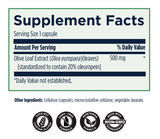Olive Leaf Extract
Vendor: Designs for Health
Product Details
|
To access our exclusive Practitioner range supplements, you have the following options:
Looking for Personalized Health Guidance?
|
90 Capsules.
Multipurpose compound with antimicrobial properties and cardiometabolic support
Designs for Health’s Olive Leaf Extract offers 500 mg olive leaf (Olea europaea) extract per 1-capsule serving, standardized to contain 20% oleuropein, its primary bioactive phenolic constituent.
The olive tree has been studied for centuries and a host of medicinal benefits have been attributed to its constituent parts. Olive oil, buds, leaves, and roots have all been used medicinally, but olive leaf extract is of exceptional interest.
Numerous studies support a therapeutic role for olive leaf extract, oleuropein, and its precursors, tyrosol and hydroxytyrosol.1-4 Olive leaf extract (OLE) is best known as an antiviral, antibacterial, antifungal and antiparasitic agent with efficacy against a spectrum of infectious organisms, including both gram-positive and gram-negative bacteria, Candida albicans, Campylobacter jejuni, H. pylori, E. coli, Klebsiella pneumoniae, Staphylococcus aureus (including MRSA), HIV, and respiratory syncytial virus, a common cause of upper respiratory infections.
It may be especially effective against organisms that affect the intestinal or respiratory tracts
Cardiovascular Health
Olive oil is celebrated for its beneficial effects on cardiovascular function, which are typically attributed to its high concentration of monounsaturated fatty acids and also the high content of polyphenols and antioxidants. (Some of the polyphenols of interest are responsible for the sting or mild burning sensation at the back of the throat when consuming a strong, pure olive oil.) Olive leaves contain largely the same polyphenols, making them a viable source of concentrated extract. OLE exhibits antioxidant, antihypertensive, hypoglycemic and hypocholesterolemic activity.
Metabolic Syndrome, Insulin Sensitivity and Glycemic Control
Cardiovascular disease is the most common cause of death among those with type 2 diabetes, and atherogenic dyslipidemia (low HDL, high triglycerides) is part of the diagnostic criteria for metabolic syndrome. With this in mind, it is not surprising that the beneficial effects of OLE on the cardiovascular system are mirrored with regard to insulin sensitivity and glycemic control in animals and humans.
Highlights:
• Antiviral, antibacterial, antifungal and antiparastic properties
• Supports healthy blood pressure and platelet function
• Promotes normal insulin sensitivity and glycemic control
• Powerful antioxidant activity





